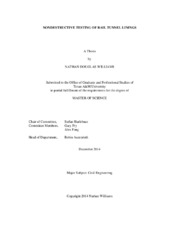| dc.description.abstract | Rail tunnel linings are currently visually inspected and hammer sounded on all structural elements at random locations or where visual inspection shows the need for it. These methods are good; however, there will not always be visual signs of problems that occur below the surface. Therefore, nondestructive testing methods need to be implemented into inspection techniques to provide information below the surface of the lining. The best approach would be to use relatively fast methods to determine potential problems and then test those areas with slow, detailed methods. This would provide a more thorough investigation of the tunnel lining’s health.
Infrared thermography (IRT), ground penetrating radar (GPR), and ultrasonic tomography (UST) techniques were used to do blind testing of slabs and field testing of tunnels. Once the blind testing of the slabs was complete, the data analysis was compared to the known conditions of the slabs. This provided information on the limitations, accuracy, and ease of use for each device. The two slow, detailed methods (UST and GPR) detected all of the anomalies within the slabs when the data was analyzed together. The depths of the problems determined from the devices was fairly accurate with an average delta of 10.6 mm. The infrared camera was only able to detect the shallowest problems. The field testing provided more information on limitations and testing procedures. The first tunnels tested were the five tunnels along the Historic Railroad Trail. The tunnels were bare rock and too rough for the devices. The changes in surface area created temperature variations that limited the effectiveness of the infrared imaging. Also, one area was tested with the UST but no useful information was provided. Finally, the Moab Tunnel was tested which had concrete lined sections. The infrared was able to locate two testing areas and one of them had an anomaly that was found with both the GPR and UST. When testing with the infrared camera, scans need to be taken traveling in both directions so that both perspectives are seen. The two detailed methods provided information on how the lining was constructed by finding the rebar and reinforcing beams. Ultimately, the methods worked well for inspecting the tunnel and the data resulted in a better understanding of the structure underneath the surface. | en |


